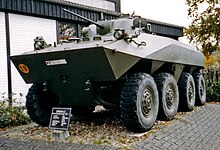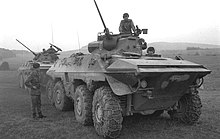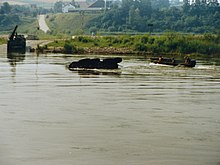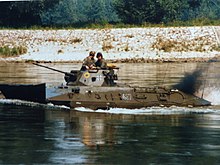Lynx (reconnaissance armor)
| Spähpanzer 2 "Lynx" | |
|---|---|

Lynx in the Munster Tank Museum (2008) |
|
| General properties | |
| crew | 4 men |
| length | 7.34 m |
| width | 2.98 m |
| height | 2.50 m |
| Dimensions | 19.6 t |
| Armor and armament | |
| Armor | SmK safe |
| Main armament | 1 × 20 mm MK |
| Secondary armament | 1 × 7.62mm MG3 |
| agility | |
| drive | 10-cylinder multi-fuel Daimler-Benz engine with 390 hp |
| suspension | Coil springs with shock absorbers |
| Top speed | 90 km / h (road) |
| Power / weight | 20 hp / t |
| Range | 800 km (road) |
The Spähpanzer 2 (SpPz 2) Luchs was an eight-wheeled amphibious reconnaissance tank from German production that was used by the Bundeswehr from the 1970s to 2009.
vehicle description
The Bundeswehr's Luchs reconnaissance vehicle is a wheeled armored vehicle that was mainly used in the armored reconnaissance battalions of the divisions . It is based on the concept of the Sd.Kfz armored car. 234 and its predecessor, the Sd.Kfz. 231 , of which he kept the 8-wheel steering and, as an additional crew member, the reverse driver. In addition, the lynx is able to swim (it is driven by two rudder propellers located in the stern when driving in the water), barely audible and equipped with bulletproof tires. The crew model is also identical: driver, commander , gunner and reverse driver (radio operator). With the Panzerkampfwagen II Ausf. L (Sd.Kfz. 123) "Luchs" introduced by the German Wehrmacht , today's "Luchs" tank only has its name in common.
Development and use
The vehicle was developed by Porsche 1968–1974 (as a commissioned work for Daimler-Benz ), and finished in 1975 by Thyssen-Henschel in Kassel . Series production began in May 1975, the introduction to the troops from September 1975. By 1977 a total of 408 copies had been delivered. The lynx replaced the French Hotchkiss SPz 11-2, which had already been used in the Bundeswehr for 20 years. At the same time, the "Fuchs" armored transport vehicle was developed, with which it shares many components.
The lynx's tub is made of welded steel. The drive unit, consisting of the engine, automatic transmission and various air and oil filters, is "classically" located in the rear of the vehicle and can be exchanged in one block. This makes the lynx a maintenance-friendly weapon system. Driven by a multi-fuel engine , different fuels - including diesel and gasoline - can be used. Powered by diesel, the ten-cylinder engine delivers around 285 kW at 2500 rpm. All eight wheels are driven; the control acts either on the four front wheels, the four rear wheels or on all eight wheels. The eight large-volume, low-pressure tires have run-flat properties; All four axles can be steered for speeds of up to 30 km / h. This makes the Luchs an agile and highly manoeuvrable vehicle. Reaching the top speed is also possible when reversing thanks to the reverse driver.
Due to its extensive noise insulation, the lynx was barely audible, especially against the background of ambient noise, even at short distances. Safety precautions were therefore taken for its operation: When the SpPz Luchs was in the maneuver, it was only allowed to sleep on the floor in specially designated areas; otherwise there was a risk that sleeping soldiers would be run over. Despite the use of the thermal imaging device , the crew did not always have the opportunity to watch out for any sleepers in the access room.
In connection with a need for repairs, the vehicles were retrofitted with a double belt feeder (DGZ) for either explosive and hard core ammunition (LUCHS A1) between 1980 and 1983. From 1985 the vehicles received a thermal imaging device (version SpPz 2), the IR / white light target headlights were omitted. After an accident while swimming on the Danube near Eining on July 18, 1986 with a Lynx A2, in which all crew members were able to leave the vehicle for the first time and remained alive, amphibious swimming was initially stopped. The increase in weight and center of gravity associated with the renovation led to the loss of the swimming permit. The vehicle has an integrated NBC protection ventilation system.
The lynx is not intended for combat missions - rather, it is intended to spy out enemy positions and movements unnoticed. The SpPz 2 "Luchs" A2 was used as escort protection for convoy escorts by IFOR in Croatia and Bosnia and by KFOR in Kosovo. He also served with SFOR in Bosnia and Herzegovina as part of peacekeeping. Some of the vehicles used there, as well as some of those stationed in Macedonia and Kosovo, had been upgraded.
Armament and equipment
- On-board machine cannon Rh 202 cal. 20 mm from Rheinmetall , rate of fire: 800–1000 rounds / min, combat distance up to 2000 m, main combat distance 800 m, double belt feed (from version A1)
- MG3 cal. 7.62 mm on rotating ring mount
- Integrated ABC protection and ventilation system
- Since the mid-1980s, increased combat value with the installation of a thermal imaging target and observation device (version A2) (since then, due to increased weight, loss of independent swimming ability)
- Increased combat value of some models by installing a GPS navigation system, a gyro compass and an additional radio data antenna
- Radio Units SEM 25 /35 , RF short-wave device XK 405 (for long range), walkie-talkies SEM 80/90 (1986)
Use and whereabouts
The lynx was last used in the brigades of the army's stabilization forces. There he served - next to the Fennek reconnaissance vehicle - in the battalions of the army reconnaissance troops that had emerged from the armored reconnaissance units in 2008 . In addition, he was deployed as part of the EUFOR (formerly IFOR , then SFOR) in Croatia and Bosnia and the KFOR in Kosovo as a convoy escort. The last 68 copies of these reconnaissance tanks were decommissioned in 2009. A pre-series and a series vehicle of the reconnaissance tank type are in the collection of the Munster Tank Museum and can be viewed there.
Technical specifications
| Reconnaissance tank lynx | |
|---|---|
| Technical specifications | |
| Introductory year: | 1975 |
| Crew: | Commander, gunner, driver, radio operator (= reversing driver ) |
| Dimensions | |
| Length: | 7340 mm, width: 2980 mm, height: 2500 mm |
| Combat mass: | 19.6 t |
| Tower mass: | 2.15 t |
| Axle load front: | 2 × 4.8 t |
| Rear axle load: | 2 × 5.0 t |
| Ground clearance: | 440 mm |
| drive | |
| Engine power: | 287 kW (390 hp) at 2500 rpm |
| Specific Drive power: | 14.6 kW / t |
| Driving range (street) : | approx. 800 km |
| Steering: | All-wheel drive with all-wheel steering, propeller drive in the water |
| Speed: | 90 km / h on roads (100 km / h, early version) , 11 km / h in water |
| Can be driven forwards and backwards | |
| Climbing ability: | approx. 0.6 m |
| Trench crossing ability: | approx. 1.90 m |
| Turning circle: | 12.05 m |
| Armament: | |
| Main weapon: | On-board machine gun 20 mm Rheinmetall MK 20 Rh 202 |
| Rate of fire: | 800-1000 rounds / min |
| Combat Distance: | up to 2000 m. |
| Secondary weapon: | MG 3 7.62 mm |
| Fog throw system: | 2 × 4 cups |
| Ammunition types: | |
| AP-T, HE-T | |
| Ammunition supply main weapon: | 500 rounds including reserves in brackets behind the tank turret |
| Straightening system: | |
| Fire control computer: | No |
| Straightening system: | electro-hydraulic |
| Stabilization: | No |
| Optics: | |
| Gunner: | Thermal imaging device |
| Commander: | WBG via light-pipe |
| Night vision devices for drivers: | Residual light intensifier |
| Bilge pumps: | 4 pieces |
| Fire extinguishing system: | in the machine room |
See also
Web links
- Bundeswehr Classix: Eight times eight - the new reconnaissance tank (Luchs) (1974) . In: YouTube . March 13, 2015 (video; 3:29 min).
- German Tank Museum: Stories made of steel: Whispers in the night - the lynx (2017) In: Youtube. November 3, 2017 (video; 13:25 min).
Individual evidence
- ↑ Soldat and Technology , 10/1975 p. 493.






